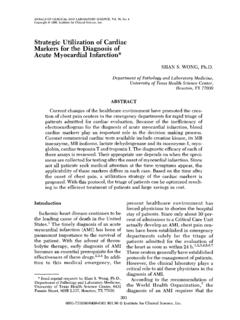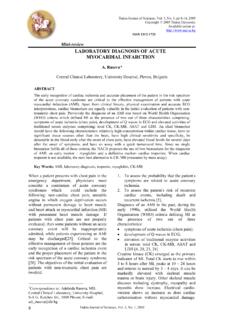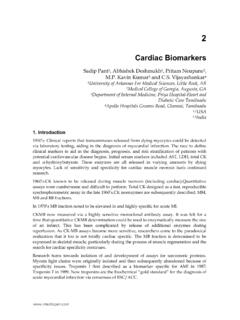Transcription of Perspectives on the impact of point-of-care testing for ...
1 Perspectives on the impact of point-of-care testing for cardiac markers on healthcare professional working relationshipsApril 2009F. J. FitzGibbonMultidisciplinary Assessment of Technology Centre for healthcare (MATCH) Programme, Nanotechnology and Integrated Bioengineering Centre, Faculty of Computing and Engineering, University of Ulster, Shore Road, Newtownabbey, Co. Antrim, Northern Ireland, UK BT37 of point-of-care testing (POCT) for diagnostic biomarker measurement in healthcare have increased significantly in recent years in a wide range of clinical scenarios. These include infectious disease, critical care, cardiology and other areas of emergency , routine clinical pathology investigations were performed by dedicated clinical biochemists and pathologists within a hospital-based central laboratory provision.
2 As an alternative, POCT aims to improve key clinical outcomes by providing for a faster test turnaround time (TAT) facilitated by being deployed in the vicinity of the addition, it has been suggested that POCT can contribute to delivering health economic benefits by reducing admissions and hospital length-of-stay costs. Despite these potential benefits, however, POCT poses a considerable challenge in its operation outside the central particular, it can have a direct impact on healthcare professional working relationships; for example, clinical and nursing staff are commonly responsible for performing diagnostic tests rather than laboratory the same time, the widespread deployment of POCT will also generate new support roles for clinical biochemists and pathology staff in the regulation and quality assurance of POCT outside the central this article, Perspectives on the likely future impact of cardiac - marker POCT on working relationships are discussed based on opinions provided in a survey of healthcare 1 Article downloaded from J.
3 FitzGibbon: Perspectives on the impact of point-of-care testing for cardiac markers on 2 Article downloaded from J. FitzGibbon: Perspectives on the impact of point-of-care testing for cardiac markers on medicine is a field where the taken time to diagnose a patient s condition in respect to a whole spectrum of diseases and conditions is critical [1-3].Emergency departments (EDs) are commonly overcrowded due to an increase in patient volume with the situation compounded by delays in accessing resources such as radiology, laboratory and ancillary services, and in waiting for available beds in wards to admit patients [4-5].The overall impact on service provision within the ED is therefore an increase in patient wait times and delays in time to has been reported that chest pain accounts for 6 % of all attendances to the ED and 27 % of all admissions [4-7].
4 Patients presenting at the ED with chest pain often undergo extensive diagnostic testing and risk stratification to diagnose acute coronary syndrome (ACS) and determine the likelihood of future adverse cardiac events [4-10].Chest pain is a time-consuming diagnostic dilemma for the physician and can be either cardiac or non- cardiac in etiology with a range of risk from benign to life-threatening illness requiring rapid diagnosis and treatment [8, 11].To better identify which patients need extensive diagnostic investigation, several different clinical protocols have been described recently, many of which use point-of-care testing (POCT) for the measurement of acute cardiac markers as diagnostic indicators [4-7, 10, 12].
5 The process of clinical decision making (CDM) can be described via a patient pathway, which maps the episodes of care provided to the patient [1]. It can be considered as a timeline on which every event relating to treatment can be entered [1, 13-16].These pathway events include consultation, diagnosis, assessment, treatment, medication and preparation for discharge from hospital all of which can then be mapped on this a time-based management approach the process is divided into a number of patient episodes [1] that describe what actually happens to a patient in the sequence of pathway events from first contact to closing of the case [1, 13-16].This article provides a perspective on how relationships between various healthcare professionals, (clinicians, nurses and central pathology laboratory staff), can be altered through the introduction of a new and emerging technology within the patient CDM , the application of cardiac - marker POCT in emergency medicine is presented as a case study.
6 The information provided is based on the opinions of the POCT method garnered from a survey of various healthcare professionals in Northern Ireland [4].Health technology assessment of the impact of cardiac - marker POCTIt is argued that a contributor to increasing costs in the provision of healthcare for organizations such as the UK National healthcare System (NHS) is the emergence of new and expensive technologies. Estimates suggest that technological advances cause NHS costs to rise by an average of % per year [17].Evidence of the clinical and cost effectiveness of such technologies, together with systematic evaluation of actual health outcomes, has therefore become a key part of the policy for delivery of clinical services, which is increasingly being driven by such evidence-based approaches [2, 17].
7 In this regard, a form of Health Technology Assessment (HTA) has been adopted by many countries with the aim of influencing health policy decision making by the introduction of evidence-based clinical objective of HTA is to determine the value and benefits of new health technologies and medical devices Page 3 Page 2 Article downloaded from downloaded from J. FitzGibbon: Perspectives on the impact of point-of-care testing for cardiac markers on terms of improving clinical and health economic outcomes [2 ,4, 17-18]. Before a new medical device or healthcare technology is introduced into the UK NHS, a HTA appraisal is carried out in order to formulate an early-stage evidence-based business case to clearly demonstrate its value and appraisal will involve inter alia a combination of health economics, cost effective analysis, human factors engineering, user perspective and patient pathways analysis [2, 4, 13, 15, 17-18].
8 The MATCH Innovative Manufacturing Research Centre ( ) is a university-based research collaboration working in the area of HTA and has recently carried out a patient pathway assessment of the impact of introducing POCT in the ED for cardiac - marker measurement in patients presenting with chest pain [4, 6].The outcomes from this study have highlighted a number of interesting Perspectives for the introduction of new technologies and in particular on how they can affect working relationships between healthcare organisation - regulators and usersThe impact of POCT on working relationships between healthcare professionals is seen by two main groups: POCT regulators and POCT users [4, 20]. Since POCT devices are intended to be used outside the central pathology laboratory (Lab) as decentralized solutions, POCT device users are essentially clinicians and nurses with the latter often making up the most significant element of the user group [4].
9 Staff in the Lab is normally responsible for maintaining and recording all data and ensuring compliance with regulation and Quality Assurance relating to diagnostic testing in clinical setting. This includes both internal and external QA validation and audits [20].However, in the case of POCT this may not always be the case since the devices are deployed more increased level of hospital testing therefore necessitates a more formal architecture for POCT organization within a typical NHS Health Trust as shown in Fig. 1. In this regard, it is suggested that the Lab Director must play a key role in POCT can be facilitated via a POCT coordinator and POCT committee and the POCT team comprises an administrative group, which manages POCT processes to meet the needs of both patients and , there is a clear indication from our previous study [4] that there is willingness from the Lab staff to undertake this type of role.
10 Importantly, this will add real value to the validity of the POCT data recorded and ensure that it fits within the required QA POCT coordinator can then manage the routine use of the POCT devices with the CLP director ensuring that there is adequate control over the entire POCT program through regular reviewing of policies and compliance with procedures and CPA regulations in the case of multiple-site this way, the laboratory director will assist in the full clinical interpretation and governance of POCT results [20].This approach is not without its challenges since, unlike the Lab in which most diagnostic testing is carried out on a few high-throughput clinical analyzers by a small number of trained technical staff, POCT is performed by a wide variety of clinical and nursing staff on multiple POCT devices in several different locations, as indicated in Table focus of these users is on patient care delivery, not on the routine standard operating procedures of instrument calibration and quality control and they are not generally trained in good laboratory practice and quality control ensuring that all staff performs POCT in a consistent manner each time a test is carried out represents a logistical challenge [6-7, 11.]









